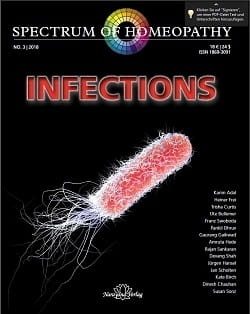Infections - Spectrum of Homeopathy 2018/3
The development of vaccines and antibiotics is one of the most significant milestones in the history of medicine. Many life-threatening epidemics have lost their horror and life expectancy has risen as a result. Does homeopathy have a rightful place in the treatment of infectious disease in view of this indisputable success of scientific medicine? The cases in this issue of SPECTRUM offer an unequivocal answer to this provocative question. The many patients in these cases were not helped by antibiotics alone. When infections of the sinuses, bronchi or bladder recur despite repeated antibiotic treatment, another approach is required. Homeopathy is not directed against the pathogen, rather it strengthens the terrain, milieu, immune system or the body‘s defences and vital force. It therefore has a special role to play in the treatment of chronic recurrent infections, especially when antibiotics have failed.
A typical indication is chronic sinusitis. Karim Adal and Heiner Frei present two similar cases involving many years of suffering and ineffective treatment with antibiotics, corticosteroids, antihistamines and even surgical interventions. The two Swiss homeopaths follow very different paths – the sensation method and polarity analysis – to arrive at constitutional remedies that promptly relieve the patient‘s symptoms, leading to complete healing. Frei’s successful treatment is even documented with computer tomography. Like chronic sinusitis, recurrent urinary tract infections are also a bane of conventional medicine. Trisha Curtis reports on the special value of Populus tremuloides for this illness and notes that Jan Scholten’s plant theory can retrospectively confirm her prescription. With virus infections, the targeted strengthening of the vital force and therefore the immune system has a special role to play due to the lack of alternatives. For the human papillomavirus infection, the gynecologist Ute Bullemer shows how treatment with homeopathic sycotic remedies such as Thuja or Acidum nitricum not only causes the condylomas to disappear but can also help normalize pathological cervical smears with dysplasia. The Indian authors from the homeopathic academy “The Other Song” in Mumbai are similarly successful in their treatment of the herpes virus.
Particularly in the developing world, homeopathy is also used for infectious diseases that are solely treated with antibiotics in Europe. This is true, for example, in India of tuberculosis, which often appears there in a multi-resistant form. Many of those affected do not respond to standard treatments or they suffer massive side effects from the powerful drugs of last resort – or they simply cannot afford them. Dinesh Chauhan’s case clearly illustrates the promise of homeopathy in such situations. His case shows the use of a reptile remedy, as do the three cases from Susan Sonz. Originally intended for publication in the previous SPECTRUM issue on Reptiles, these cases beautifully illustrate the homeopathic treatment of various deep-seated disorders, including chronic cystitis. Comparable with tuberculosis in India, though on an even larger scale, is the problem of the HIV virus in Africa. There, too, people are becoming more experienced in the use of homeopathy and SPECTRUM has already reported several times on Jeremy Sherr’s dedication in this area. In our current issue, Jan Scholten describes his pilot study with AIDS patients in Africa using a homeopathic complex remedy which is given in many cases alongside antiretroviral medication. A pronounced increase in the vital force was accompanied by a noticeable reduction in opportunistic infections. Kate Birch, with her extensive experience in the treatment and prevention of infectious diseases, describes the importance of infections for the development of the immune system, and various homeopathic approaches to infections, as well as the issue of vaccine damage.
Whereas nowadays homeopaths are frequently disqualified from treating epidemics such as tuberculosis or AIDS, it was precisely the success of homeopathic treatment of an equally deadly plague, cholera, that helped homeopathy to a breakthrough in the 19th century. We highlight this episode in medical history to plead for constructive cooperation between conventional medicine and homeopathy in the treatment of epidemics. With the genius epidemicus already described by Hahnemann, we have the potential to target the patients’ bodily defences at an early point in the outbreak of infectious disease. Franz Swoboda discusses the costs and benefits of using the genius epidemicus based on his experience with Antimonium tartaricum and the mycoplasm nosodes. In the best-case scenario, this even helps us find the similimum for a chronically ill patient. But even without such strokes of luck, homeopathy has earned its rightful place in the treatment of both acute and chronic infections.
- Author: Narayana Verlag
- ISBN: No ISBN
- 92 pages
- Paperback
- Published in 2018
- Printed in Germany

